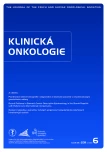Naše päťročné výsledky in vitro testovania chemorezistencie u onkologických pacientov
Authors:
J. Hatok 1; T. Matáková 1; J. Jurečeková 1; J. Chudej 2; P. Chudý 2; E. Huľo 3; Anton Dzian 3; Ľ. Strelka 3; D. Dobrota 1; P. Račay 1
Authors‘ workplace:
Ústav lekárskej biochémie, JLF UK Martin, Slovenská republika
1; Klinika hematológie a transfuziológie, JLF UK a UNM Martin, Slovenská republika
2; Chirurgická klinika, JLF UK a UNM Martin, Slovenská republika
3
Published in:
Klin Onkol 2011; 24(6): 443-446
Category:
Original Articles
Overview
Backgrounds:
Translational medicine is a medical field encompassing basic research and development of new diagnostic and therapeutic strategies for clinical practice. The present scientific paper focuses on our previous experience in the field of chemoresistance testing in patients with oncological diseases.
Material and Methods:
Since 2005, we sampled 71 patients with a leukaemia (AML, ALL and CML) and 92 patients with a solid tumour (lung and gastrointestinal tract cancer). Malignant cell in vitro drug resistance testing was carried out using cytotoxic methyl-thiazol tetrazolium (MTT) assay.
Results:
Based on the LC50 (lethal concentration of a drug killing 50% of cell population), we found that patients with acute myeloblastic leukaemia exhibit a greater degree of resistance than patients with acute lymphoblastic leukaemia. In patients with bronchogenic carcinomas, primary resistance to cisplatin was identified in 28 % of tested samples, paclitaxel 36%, vincristine 50%, etoposide 56%, vinorelbine 57%, topotecan 62%, gemcitabine 77% and dacarbazine 86%.
Conclusion:
In vitro tests with gastrointestinal tract cancers also suggested high effectiveness of cisplatin (with the exception of gastric carcinoma) that was comparable with 5-fluorouracil. Even though the MTT assay has some limitations (insufficient number of vital cells, possible contamination by non-malignant cells, etc.), this in vitro method proved very effective in testing malignant cell resistance to clinically used cytostatics.
Key words:
translational medicine – chemoresistance – in vitro testing – malignity
This project has been supported by the Centre for Translational Research co-financed by the EU and European Regional Development Fund.
The authors declare they have no potential conflicts of interest concerning drugs, products, or services used in the study.
The Editorial Board declares that the manuscript met the ICMJE “uniform requirements” for biomedical papers.
Submitted:
17. 1. 2011
Accepted:
21. 11. 2011
Sources
1. Redmond KM, Wilson TR, Johnston PG et al. Resistance mechanisms to cancer chemotherapy. Front Biosci 2008; 13: 5138–5154.
2. Hatok J, Babusikova E, Matakova T et al. In vitro assays for the evaluation of drug resistance in tumor cells. Clin Exp Med 2009; 9(1): 1–7.
3. Mosmann T. Rapid colorimetric assay for cellular growth and survival: application to proliferation and cytotoxicity assays. J Immunol Methods 1983; 65(1–2): 55–63.
4. Kaspers GJ, Pieters R, Van Zantwijk CH et al. In vitro drug sensitivity of normal peripheral blood lymphocytes and childhood leukaemic cells from bone marrow and peripheral blood. Br J Cancer 1991; 64(3): 469–474.
5. Stone RM, O’Donnell MR, Sekeres MA. Acute myeloid leukemia. Hematology Am Soc Hematol Educ Program 2004; 98–117.
6. Hajdúch M, Mihál V, Minarík J et al. Decreased in vitro chemosensitivity of tumour cells in patients suffering from malignant diseases with poor prognosis. Cytotechnology 1996; 19(3): 243–245.
7. Matáková T, Hatok J, Sivoňová M et al. Testovanie chemorezistencie nádorových buniek MTT testom u onkochirurgických pacientov s bronchogénnym karcinómom a nádormi gastrointestinálneho traktu. Medicina Militaris Slovaca 2008; 10(1): 15–19.
8. Benson AB. Gastrointestinal oncology. Kluwer Academic publisher 1999; 25–36.
Labels
Paediatric clinical oncology Surgery Clinical oncologyArticle was published in
Clinical Oncology

2011 Issue 6
Most read in this issue
- Castleman Disease
- Long Term Follow up of Eosinophilic Granuloma of the Rib
- Trabectedin Registry
- Predictive Values of the Ultrasound Parameters, CA-125 and Risk of Malignancy Index in Patients with Ovarian Cancer
